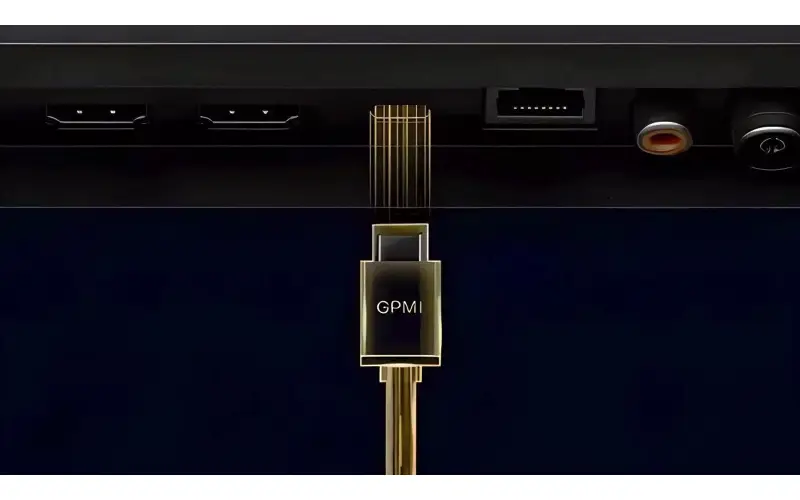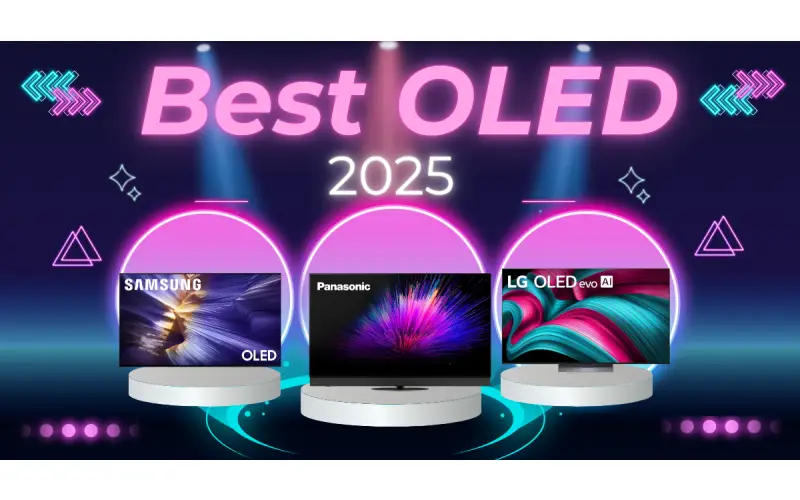By: Dipin Sehdev
The landscape of display connectivity is on the cusp of a significant evolution, with the emergence of the General Purpose Media Interface (GPMI). Spearheaded by a consortium of over 50 Chinese tech giants, including industry titans like Hisense and TCL, GPMI arrives with ambitious claims of superior bandwidth and unified functionality. This new standard aims to consolidate video, audio, data, and power delivery into a single cable, potentially streamlining the intricate web of connections that currently define our digital experiences.
Boasting a staggering peak bandwidth of 192 Gbps in its proprietary Type-B configuration, GPMI immediately positions itself as a formidable challenger to existing interface technologies. Even its USB-C compatible variant promises a robust 96 Gbps, matching the recently unveiled HDMI 2.2 specification. This leap in bandwidth unlocks a realm of possibilities for higher resolutions, faster refresh rates, and richer color depths, paving the way for truly immersive visual experiences.
Bandwidth Unleashed: GPMI vs. the Current Landscape
To truly appreciate the potential of GPMI, it's crucial to contextualize its bandwidth capabilities against established standards. Let's delve into a comparative analysis:
- GPMI Type-B: Leading the pack with an impressive 192 Gbps, this dedicated connector promises to handle even the most demanding future display technologies with ease.
- GPMI Type-C: Leveraging the ubiquitous USB-C interface, this version delivers a substantial 96 Gbps, aligning it directly with the cutting-edge HDMI 2.2 standard.
- HDMI 2.2 (FRL): The latest iteration of the widely adopted HDMI standard also achieves 96 Gbps, signifying a significant step forward for the incumbent.
- HDMI 2.1 (FRL): While still prevalent, HDMI 2.1's fixed rate link (FRL) technology caps out at 48 Gbps, placing it at a disadvantage compared to the newer contenders for high-bandwidth applications.
- HDMI 2.1 (TMDS): The transition-minimized differential signaling (TMDS) mode of HDMI 2.1 offers a more modest 18 Gbps, highlighting the performance gains offered by newer standards.
- Thunderbolt 5: Intel's latest high-speed interface reaches 120 Gbps, positioning it as a strong contender for both display and peripheral connectivity.
- Thunderbolt 4: While capable, Thunderbolt 4's 40 Gbps bandwidth, though versatile, falls short of the peak capabilities of GPMI and HDMI 2.2 for purely display-centric applications.
- DisplayPort 2.1 (UHBR20): Offering a competitive 80 Gbps, DisplayPort remains a strong choice for high-performance monitors.
This comparison clearly illustrates GPMI's potential to significantly elevate the bandwidth ceiling for display connectivity. The Type-B connector, in particular, offers a substantial advantage, hinting at its readiness for future resolutions and refresh rates that may push the limits of current standards.
Powering the Future: GPMI's Integrated Power Delivery
Beyond raw bandwidth, GPMI distinguishes itself by integrating robust power delivery capabilities. This is a crucial differentiator, especially when compared to traditional display interfaces like HDMI and DisplayPort, which primarily focus on signal transmission.
- GPMI Type-B: Can deliver an impressive 480W of power, opening doors for powering a wider range of devices directly through the display cable.
- GPMI Type-C: Offers a substantial 240W power delivery, matching the Extended Power Range (EPR) of the latest USB-C specifications.
- Thunderbolt 5: Also supports 240W power delivery, aligning it with GPMI Type-C in this aspect.
- Thunderbolt 4: Provides up to 100W of power delivery.
- USB-C (EPR): Capable of delivering up to 240W.
The ability to deliver significant power alongside high-bandwidth data transmission simplifies connectivity, potentially eliminating the need for separate power cables for many devices. Imagine a future where your high-refresh-rate gaming monitor or even a powerful laptop receives both its display signal and power through a single, sleek GPMI cable.
The USB-C Advantage: A Bridge to Wider Adoption
The strategic decision to offer a USB-C compatible version of GPMI is a masterstroke. USB-C has rapidly become a ubiquitous port on a vast array of devices, from laptops and smartphones to monitors and docking stations. Leveraging this existing infrastructure provides GPMI with an immediate pathway to broader adoption.
While the peak bandwidth and power delivery of GPMI are realized through its dedicated Type-B connector, the 96 Gbps and 240W offered via USB-C are still a significant upgrade over many existing USB-C implementations and align perfectly with the capabilities of HDMI 2.2. This compatibility allows manufacturers to integrate GPMI into their devices without requiring a complete overhaul of existing port designs.
A Stepping Stone: The HDMI Form Factor and Market Transition
The physical resemblance of the GPMI Type-B connector to the familiar HDMI port is an intriguing design choice. While it is a new, distinct connector, the similar form factor could serve as a subtle bridge for manufacturers and consumers alike. For manufacturers accustomed to implementing HDMI ports in their televisions and displays, the GPMI Type-B might represent a less disruptive transition compared to adopting an entirely novel connector shape.
This visual familiarity could also ease consumer adoption. The act of plugging in a GPMI Type-B cable will feel inherently similar to connecting an HDMI cable, potentially reducing the learning curve associated with a new interface. This subtle yet significant aspect could play a crucial role in GPMI gaining traction in the market.
While the ultimate goal might be a unified ecosystem centered around USB-C, the GPMI Type-B, with its enhanced capabilities and HDMI-like form factor, could act as a powerful stepping stone. It allows for the introduction of GPMI's superior bandwidth and power delivery in a form that manufacturers are already comfortable with, potentially paving the way for a more seamless integration of its USB-C variant down the line.
Unleashing the Potential of 12-Bit Panels and Dolby Vision
The substantial bandwidth offered by GPMI holds the key to unlocking the full potential of advanced display technologies. Consider the increasing prevalence of high-dynamic-range (HDR) content, particularly Dolby Vision, which demands significant data throughput to deliver its nuanced brightness, contrast, and color information.
Current bandwidth limitations can sometimes necessitate compromises in color depth or chroma subsampling when displaying high-resolution, high-frame-rate HDR content. GPMI's ample bandwidth, especially the 96 Gbps and 192 Gbps offered by its Type-C and Type-B variants, respectively, could alleviate these bottlenecks.
This opens the door for widespread adoption of true 12-bit color panels. Unlike the more common 8-bit or 10-bit panels, 12-bit displays can reproduce a staggering 68.7 billion colors, resulting in smoother gradients, finer detail in shadows and highlights, and an overall more lifelike and immersive visual experience. The bandwidth headroom provided by GPMI ensures that this vast color information can be transmitted without compression or loss of fidelity, allowing viewers to experience content exactly as the creators intended.
Furthermore, GPMI's bandwidth prowess is perfectly poised to support the full capabilities of Dolby Vision. This advanced HDR format utilizes dynamic metadata, which adjusts the HDR parameters on a scene-by-scene or even frame-by-frame basis, optimizing the image for the specific capabilities of the display. Transmitting this dynamic metadata alongside high-resolution, high-frame-rate 12-bit video requires significant bandwidth, a demand that GPMI is well-equipped to meet. The result will be a more dynamic, detailed, and visually stunning presentation of Dolby Vision content on compatible displays.
A Boon for Gamers: Fidelity and Frame Rates Elevated
The gaming community stands to gain significantly from the advancements offered by GPMI. In the pursuit of the most immersive and responsive gaming experiences, high refresh rates and uncompromised visual fidelity are paramount.
GPMI's high bandwidth capacity directly translates to the ability to drive higher frame rates at higher resolutions. For gamers, this means the potential for smoother, more fluid gameplay at 4K, 8K, and beyond. The increased data throughput ensures that every frame rendered by a powerful gaming PC or console can be transmitted to the display without bottlenecks, resulting in reduced motion blur and a more responsive feel. Imagine playing demanding AAA titles at pristine 4K resolution with buttery-smooth frame rates exceeding 120Hz – GPMI makes this a more attainable reality.
Furthermore, GPMI's support for higher color depths, potentially enabling widespread adoption of 10-bit or even 12-bit gaming displays, will significantly enhance visual fidelity. Games will appear more vibrant, with richer color palettes and smoother gradients, adding another layer of immersion to the gaming experience. The subtle nuances in lighting and textures will be more accurately rendered, drawing players deeper into the virtual world.
The combination of higher frame rates and increased color fidelity, facilitated by GPMI's robust bandwidth, promises to elevate the gaming experience to new heights, offering a level of visual clarity and responsiveness that was previously unattainable.
A Unified Future: Simplifying Connectivity
One of GPMI's core objectives is to simplify the often-cluttered landscape of display connectivity. The promise of a single cable capable of handling video, audio, data, and power is an appealing prospect for both consumers and professionals.
Imagine a streamlined setup where your monitor receives its display signal, power, and even network connectivity through a single GPMI cable connected to your laptop. Or a home entertainment system where your Blu-ray player transmits high-resolution video and immersive audio to your TV while also receiving power through the same GPMI connection. This reduction in cable clutter not only improves aesthetics but also simplifies setup and reduces the potential for tangled messes.
The inclusion of a control protocol similar to HDMI CEC further enhances this unification. This allows for seamless control of multiple GPMI-connected devices with a single remote, eliminating the need to juggle different controllers for your TV, soundbar, and media player. This level of integration promises a more intuitive and user-friendly experience.
While USB-C already offers a degree of this unified functionality, GPMI's significantly higher bandwidth and power delivery capabilities expand the possibilities. It could potentially become the true single-cable solution for a wider range of devices and applications.
Backed by Chinese Innovation: A New Era of Competition
The strong backing of GPMI by a powerful coalition of over 50 Chinese technology companies, including major players like Huawei, Hisense, Skyworth, and TCL, signifies a serious commitment to this new standard. These companies possess significant manufacturing capabilities and a strong presence in the global consumer electronics market. Their collective support provides GPMI with a substantial launchpad and the potential for rapid adoption, at least within the Chinese market.
This initiative also injects a new dynamic into the display connectivity landscape, which has been largely dominated by established Western and Japanese standards like HDMI and DisplayPort. GPMI represents a significant technological advancement originating from China, showcasing the country's growing innovation and ambition in the technology sector.
While the absence of major South Korean and Japanese manufacturers in the initial backing of GPMI raises questions about its immediate global reach, the potential for its superior capabilities to attract wider industry support in the future remains significant. The performance advantages offered by GPMI could eventually compel other major players to consider its adoption, especially if it gains significant traction in the Chinese market.
A Positive Outlook: Embracing the Future of Display Connectivity
The emergence of GPMI is a positive development for the display technology industry and consumers alike. Its promise of significantly higher bandwidth, integrated power delivery, and unified functionality has the potential to revolutionize how we connect our devices and experience digital content.
While the transition to a new standard always presents challenges, the strategic decision to offer a USB-C compatible version and the potential for a smoother transition from HDMI due to the Type-B connector's form factor are encouraging signs. The strong backing from major Chinese manufacturers provides a solid foundation for its initial adoption.
The benefits for consumers are clear: the potential for higher resolution displays with faster refresh rates and richer color depths, a simplified cable ecosystem, and a more integrated user experience. For gamers, GPMI offers the promise of unparalleled visual fidelity and smoother, more responsive gameplay.
The journey of GPMI from its launch to widespread global adoption will undoubtedly be an interesting one to watch. However, its impressive technical specifications and the strong industry support behind it suggest that it is a serious contender that could shape the future of display connectivity for years to come. The potential to unlock true 12-bit panels and the full glory of Dolby Vision, coupled with the promise of a superior gaming experience, makes GPMI a truly exciting development in the world of display technology. The industry stands to benefit from this innovation, pushing the boundaries of visual fidelity and simplifying the way we interact with our digital world.





